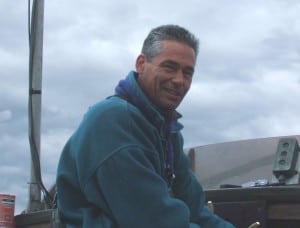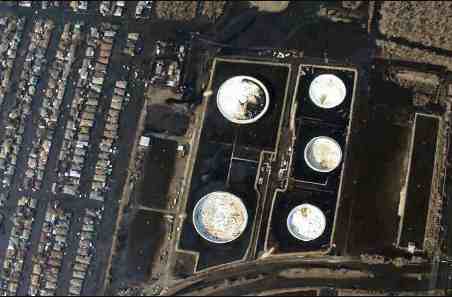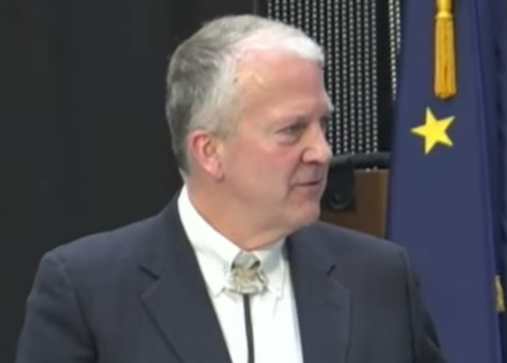 Since I spoke with the Alaska Native News last, I pondered why corporations, such as “big oil,” who jump at every chance to cut costs, would not want to reduce their liability caused by oil spills by incorporating new techniques for oil spill response. I wondered why BP, who at last count had $42 billion dollars in fines, with another possible $18 billion hanging over their heads, would not be interested in a system that could have greatly reduced the damage, and thus their costs, from the Gulf blow out. It does not add up.
Since I spoke with the Alaska Native News last, I pondered why corporations, such as “big oil,” who jump at every chance to cut costs, would not want to reduce their liability caused by oil spills by incorporating new techniques for oil spill response. I wondered why BP, who at last count had $42 billion dollars in fines, with another possible $18 billion hanging over their heads, would not be interested in a system that could have greatly reduced the damage, and thus their costs, from the Gulf blow out. It does not add up.
If you or I were to have as bad a driving record as big oil has had with oil spills, we wouldn’t be able to afford car insurance. I have since researched “big oil” insurance underwriters. I have also informed at least a dozen of insurance companies of Retriever Environmental’s patented oil spill response improvements, yet no one from the insurance industry was getting back to me. When I called all were out of office, etc…I feel as though I basically got the run around.
So, I contacted the head of the government insurance industry, the US insurance commissioners office. After a long struggle on my part, the US insurance commission informed me that even though they saw that I had improvements to help reduce the cost of large oil spills, there is no protocol in place to make “big oil” improve… Period.
So, I feel I now know how “big oil” tells the insurance industry how it will work. It tells our government, our regulatory agencies how to proceed. It’s amazing how deep and far “big oil” has corrupted government, and dictated to other industries.
People who buy insurance, are paying for big oil’s indifference to the environment, and letting you pay the bill.
I also contacted Alaska’s senator, Lisa murkowski, and informed her office of the ways that improved oil response and mitigation would protect America, assist in retaining existing jobs, as well as create new jobs producing improved technology for oil spills world wide.
My communication to her office was confirmed, and I received notice that her office was passing the information on to the House Resources Committee. But, I never heard back from Murkowski’s office, or the House Resources Committee….nothing.
For the third time, I contacted Alaska’s senator, Mark Begich, who also confirmed my communication, and informed me his office would contact the correct personnel at the USCG, who is in charge of oil spills in the United States and pass those names to me for further communication. I was assured he would inform me of the persons contacted. No word ever came back from Senator Begich’s office again.
Next I contacted the United States Coast Guard-Arctic command, and the USCG 17th district in Juneau Alaska, as well as the USCG Astoria Group, Public Relations office. Not a word back from any of the 3 USCG offices.
Next, I contacted every Canadian EPA, and other regulatory agencies listed for oil spills. Not one word back.
Then the British Columbia Premier, Christy Clark, came out in Canadian newspapers stating that British Columbia needed better oil spill response ahead of tar sands pipeline crude shipments by tankers in Canadian and Alaskan waters near prince Rupert, BC. I wrote to Clark’s office explaining my difficulty with getting anyone in government to listen, and offered my Open Ocean System to be reviewed by the best engineering university B.C. had to offer in order to assess if my system is credible or not. Not one word came back from BC.
After reaching out to British Columbia’s Premier, the eastern Canadian Exxon oil spill occurred. Exxon’s Hibernia drilling platform located 200 miles offshore in the Labrador Sea off Newfoundland reported a 10 liter oil spill to the Canadian Offshore Petroleum Board. Upon further observations, the Canadian authorities questioned Exxon further about the amount spilled due to sheer size of spill, and oil sheen that was observed. Exxon then revised the spill to 1,600 liters. When the spill appeared larger than the 1,600 quote given by Exxon , Exxon again up graded the spill to be of approximately 6,000 liters. A miscalculation of 3,000%!
Exxon’s Hibernia platform is the largest in the world, and is known as a gravity-based structure, or a GBS. Gravity-based means it is just sitting there like a bowling pin, relying on gravity to maintain stability. It has its own storage for the crude oil it produces. The Hibernia platform holds a whopping 50,400,000 gallons of crude which it pumps off onto tankers. Exxon has the Hibernia s sister platform soon to come on line, and it will also have same capacity. The combined total of crude oil stored inside of Exxon’s two bowling pins is a staggering 100,800,000 gallons . Half of the Gulf of Mexico blow out.
Ironically Exxon’s Hiberia oil field is in what is known as “ice berg alley.” Wikipedia states the Labrador Sea area has one of the most turbid currents on earth. It is unbelievable how Exxon mitigates ice berg danger. They propose to simply throw a “cow rope” over a half-million ton ice berg and start towing. It can take up to 10 hours to even get an iceberg to start to move. A fascinating insight to the challenges Exxon faces regarding ice berg mitigation as revealed in this interview with the captain of Exxon’s ice berg vessel Norseman that can be read here.
I believe my patent document covers better methodology for ice berg removal. I contacted the contractor for Exxon, Maersk shipping. I have been in contact with a number of people of Maersk management , all of which informed me they would email me the proper address to send my proposed improvements to. Unfortunately, as of this post, I have not received any further response from Maersk.
The ice berg season is roughly May through August each year according to the Norseman, “Ice Wrangler” article . I have contacted a global net manufacturing company for availability to produce the system needed to protect oil rig structures such as the Hibernia and Hebron offshore platforms from a catastrophic ice berg migration where there would be zero time for what could plausibly be ineffective “cow ropes.” If I do not get a response from Exxon, who I have already contacted regarding the ice berg mitigation, and Maersk, where I have contacted three of the members of their management to discuss this issue, then I surmise my next step would be to contact the Canadian Petroleum Board.
I am of the belief that the present plan in use at the Hibernia platform for ice berg mitigation endangers the environment, the lives of the employees on the platform as well as jeopardizes the investments of Exxon stakeholders. In addition, the present plan would affect the ability of the Canadian government to collect royalties due to lost production.
Exxon’s proposed plan of ice berg mitigation brings to mind the failed attempt by Shell to keep their drill rig from washing ashore on Kodiak Island on New Years Day in 2013. Despite the presence of several oil industry vessels, tug boats from outside resources, the new high horse power vessel Shell oil had built specifically for towing the drill rig, the USCG, plus close to 1,000 people at unified command in Anchorage Alaska, Shell oil could not figure out how to save the drill rig from the shores of Ocean Bay on Sitkalidak.
The consequences of the present method of harnessing ice bergs could be far more detrimental than the incident with Shell Oil’s arctic drilling rig, which is basically a large beer can, weighing a fraction of of the weight of even a moderate-sized ice berg.
In 2008, I offered “Alaska Clean Seas,” a consortium industry companies, developed, in part for oil spill response in Alaska’s Arctic Ocean, methodology to address such issues. In this case, ice berg mitigation. Had Exxon, or shell looked at the patent document for oil spills in arctic conditions, they would have seen a solid method of ice berg removal that could have applied to Shells arctic drilling rig adrift in the Gulf of Alaska. Had “big oil” looked at the improvements offered to them, BP would have been able to mitigate the Gulf spill, Shell oil would not have lost their drilling rig.
Both companies had time to review the documents, and to have in place prototypes at the ready for real time testing.
I continue to say now, there is a better way of securing a towing system for ice bergs.
I offer to be interviewed and questioned on all of my oil spill response improvement work by any nation for review and validation. I ask that any institution, university, government, or other entity work to prove my claims wrong. If there are any engineering firms that wish to call me on the ability to have saved Shells drilling rig, or having the ability to mitigate BP deep water blow outs, by all means, contact me. I welcome the opportunity to prove to engineering that what I am saying is correct.
Jim Cobb is the owner/innovator of Retriever Environmental, an oil spill mitigation company striving to lessen the impacts of oil spills globally. He can be contacted at retriever.environmental@gmail.com.




